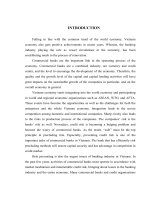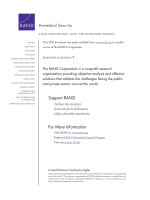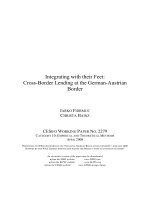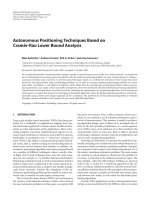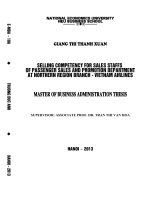Asset based lending at BIDV westlake branch analysis suggestions
Bạn đang xem bản rút gọn của tài liệu. Xem và tải ngay bản đầy đủ của tài liệu tại đây (673.22 KB, 78 trang )
Academy of Finance
Mid-term Intern Report
Asset-based lending at BIDV-Westlake branch:
Analysis & Suggestions
Instructor: Bui Thi Tuyet Mai M.A
Student: Le The Nhan
ID: 0954050074
Class: CQ47/51.03
Hanoi, 2013
1
Table of Contents
Introdution ........................................................................................................................................... 3
CHAPTER 1: SOME BASIC THEORIES ABOUT SECURITY TRANSACTIONS IN
LENDING ACTIVITY OF COMMERCIAL BANKS.................................................................................... 7
1.1............................................................................................ Lending activity of commercial bank14
1.1.1. Definition ........................................................................................................................14
1.1.2. Characteristics ................................................................................................................20
1.1.3. Elements of lendings
II............................................................................................................Assets used to secure loans 22
1. ......................................................................................................Definition of security assets 22
2. ....................................................................................................................... Types of security 23
III.General provisions of asset-based lending at Bank for Investment and Development of Vietnam syste
1. ................................................................................ Conditions of assets used to secure loans 26
2. .................................................................................................The assets to pledge, mortgage26
3. ............................................. Maximum lending range for each form of security transaction 26
CHAPTER 2: REAL SITUATION OF ASSET-BASED LENDING AT BIDV-WESTLAKE
BRANCH IN RECENT YEARS .....................................................................................................................28
I. ...................................................................................... Overview about BIDV-Westlake branch28
1. ...........................................................................................History and development progress 28
2. ......................................................................................................Main mission and functions 29
3. ............................................................................................................Organizational structure31
2
II..................................................................................................Banking activities in recent years 36
1. ...................................................... Capital mobilization situation at BIDV-Westlake branch 37
2. .............................................................Lending activity situation at BIDV-Westlake branch 38
3. ..................................................................................Performance of BIDV-Westlake branch 40
III. .....................................................Situation of asset-based lending at BIDV-Westlake branch 41
1. ................Necessary procedures of processing asset-based loan at BIDV-Westlake branch41
2. ............................................... General situation of secured loans at BIDV-Westlake branch 44
3. ...................................................Situation of asset-based lending at BIDV-Westlake branch 45
Unit: Billion VND.....................................................................................................................45
4. ......Analyze asset-based lending activity according to business sectors at BIDV-Westlake48
Unit: Billion VND................................................................... Error! Bookmark not defined.
5. ...................Analyze asset-based lending activity according to duration at BIDV-Westlake50
Unit: Billion VND.....................................................................................................................50
IV. ............................................ Assessment of asset-based lending activities in BIDV-Westlake51
1. ......................................................................................................... Opportunities and threads 51
2. ............................................................................................................................ Achievements 55
3. ......................................................................................................................................... Limits 56
CHAPTER 3: SUGGESTION FOR IMPROVING EFFECTIVENESS OF ASSET-BASED
LENDING AT BIDV-Westlake BRANCH ....................................................................................................59
I.Orientation to improve performance in asset-based lending at BIDV-Westlake branch in future
59
II..... Suggestion for improving effectiveness of asset-based lending at BIDV-Westlake branch 60
1.Mobilizing capital to expand size of asset-based lending activity at BIDV-Westlake branch
2. ....................Minimizing threads in asset-based lending activity at BIDV-Westlake branch62
3. ................................................................................................................ Preventing credit risk 64
4. .......................................................................... Treatment for bad debt and outstanding debt 65
5. ......................................................................................... Improving quality of credit officers 66
6. ....................................................................................................Applying balance offset loan 68
60
3
7. ...........................................................................................Applying Information Technology 69
III. .........................................................................................................................Recommendation 69
1. ........................................................................... Recommendations to BIDV headquarter69
2. ..................................................................................... Recommendations to local authorities 70
CONCLUSION.................................................................................................................................76
REFERENCES..................................................................................................................................77
Introduction
1
Chapter 1: SOME BASIC THEORIES ABOUT SECURITY
TRANSACTIONS IN LENDING ACTIVITY OF COMMERCIAL BANKS 4
1.1. Lending activity of commercial banks 4
1.1.1. Definition
4
1.1.2. Characteristics
1.1.3. Elements of lending
1.1.3.1. Parties
1.1.3.2. Cost of lendings
1.1.4. The role of lending activities
1.1.4.1. The role of lending activities with economy
1.1.4.2. The role of lending activities with customers
1.1.4.3. Benefits of banks
4
1.1.5. Types of lending
1.2. Assets used to secured loans
1.2.1. Definition
1.2.2. Types of security
1.3. General provisions of ABL at BIDV system
1.3.1. Conditions of assets used to secure loans
1.3.2. The assets to pledge, mortage
1.3.3. Maximum lending range for each form of security
transaction
CHAPTER 2: REAL SITUATION OF ABL AT BIDV-WESTLAKE BRANCH
IN RECENT YEARS
2.1. Overview about BIDV-Westlake branch
2.1.1. History and development progress
2.1.2. Main missions and function
2.1.3. Organizational structure
2.2. Banking activities in recent years
2.2.1. Capital mobilization situation at BIDV-Westlake branch
2.2.2. Lending activity situation at BIDV-Westlake branch
2.2.3. Performance of BIDV-Westlake branch
2.3. Situation of ABL at BIDV-Westlake branck
2.3.1. Necessary procedures of processing asset-based loans at
BIDV-Westlake branch
2.3.2. General situation of secured loans at BIDV-Westlake branch
5
2.3.3. Situation of asset-based lending at BIDV-Westlake branch
2.3.4. Analyze ABL activity according to duration at BIDVWestlake branch
2.4. Assessment of ABL activities in BIDV-Westlake branch
2.4.1. Opportunities and threads
2.4.2. Achievements
2.4.3. Limits
CHAPTER 3: CHAPTER 3: SUGGESTION FOR IMPROVING
EFFECTIVENESS OF ASSET-BASED LENDING AT BIDV-WESTLAKE
BRANCH
3.1. Orientation to improve performance in asset-based lending at BIDVWestlake branch in future
3.2. for improving effectiveness of asset-based lending at BIDV-Westlake
branch
3.2.1. Mobilizing capital to expand size of asset-based lending activity at BIDVWestlake branch
3.2.2. Minimizing threads in asset-based lending activity at BIDV-Westlake
branch
3.2.3. Preventing credit risk
3.2.4. Treatment for bad debt and outstanding debt
3.2.5. Improving quality of credit officers
3.2.6. Applying balance offset loan
6
3.2.7. Applying Information Technology
3.3. Recommendations
3.3.1. Recommendations to BIDV headquarter
3.3.2. Recommendations to local authorities
3.3.3. Recommendations to the Government
3.3.3.1.
Complete mechanisms for loan security
3.3.3.2.
Provide solutions to the valuation of collateral, pledged for the bank
and the customer
3.3.3.3.
Adjust the statute of limitations for breach of contract
3.3.3.4.
Solving problems in the handling of collateral assets of land
use rights
CONCLUSION
REFERENCES
LIST OF AVBBRIATIONS
BIDV:
Bank for Investment and Development of Vietnam
ABL:
Asset-based lending
7
LIST OF TABLES
Figure 1:
Organizational structure
Table 1:
Statistics of indicators over recent years
Table 2:
Statistics of performance in 2011-2012
Table 3:
Statistics of secured loans 2011-2012
Table 4:
Statistics of ABL activities in 2011-2012
Table 5:
ABL activities according to business sectors
Table 6:
ABL activities according to duration
Chart 1:
Capital structure by 31/12/2012
Chart 2:
Outstanding balance structure by 31/12/2012
8
DECLARATION
I hereby declare that this thesis is my own work and effort and that it has not
been submitted anywhere for any award. Where other sources of information
have been used, they have been acknowledged.
Signature:
Le The Nhan
Date:
9
ACKNOWLEDGEMENT
This thesis would not have been possible without the support of many people.
Firstly, I would like to express my profound gratitude to my honorable teacher
and supervisor, Ms. Bui Thi Tuyet Mai, a lecturer of Faculty of Foreign
Languages, Academy of Finance. She helped me a lot by proper guidance,
effective comments and with a good support. She had always paved me the right
way to conduct my internship program. She has passed a lot of time in this
respect. She was cordial to solve my problem.
Secondly, although it is very much tough to collect necessary information within
shortest possible time, I got much support from all officers and associates of
BIDV Bank, Westlake Branch, Branch Manager, staffs of Risk Management
Department. Therefore, I would like to express my great acknowledgement to
them.
At last, I am grateful to my respected teachers, Faculty of Foreign Languages,
Academy of Finance, my family, and associates for their help and co-operation
during my Internship program.
10
ABSTRACT
This thesis concentrates on gaining a full view of the situation of ABL in BIDV
Westlake. Throughout the thesis, basic information on ABL will be provided: the
definition, description and their stages. Also included in the thesis are such
figures and facts on current situation of ABL at BIDV Westlake. The thesis also
concludes with the recommendation on the application of ABL transactions in
order to improve the effectiveness of ABL in BIDV-Westlake.
Therefore, this study, tittled "An assessment on asset-based lending at BIDV
Westlake", includes the following contents:
Firstly, this thread brings out some basic theories about security transactions in
lending activity of commercial banks.
Secondly, it analyzes real situation of asset-based lending at BIDV-Westlake
Branch in recent years based on statistics in recent years.
Finally, it gives some suggestion for improving effectiveness of asset-based
lending at BIDV-Westlake branch.
In conclusion, I hope that this study will help to figure out and give suggestion
for BIDV-Westlake to overcome limits on ABL so that ABL can contribute to
bring effectiveness of credit activities as well as improve performance of the
branch.
11
INTRODUCTION
1. Rationale of the study
Vietnam's economy in recent years has attained high growth rates in comparison
to others in the region. With the current growth rate, the demand for capital for
the economy is very large. Vietnam's stock market is still so young that it has not
become a really effective channel to provide capital to the economy. The fact
shows that the majority of Vietnamese enterprises are weak in financial capacity,
forcing them to mainly rely on bank loans for operation.
Therefore, it can be confirmed that bank credit in the current period will continue
to be an important channel to provide funds of the economy. However, from the
safety and profitability points of a bank, it is extremely important to have a tool
that helps reduce risks when customers fail to repay debts, particularly when the
business environment changes all the time. And asset protection lending seems
to be a satisfying instrument.
Asset based lending (ABL), which originated in the US, is an emerging product
in Vietnam, as illustrated by the increasing number of large, complex multijurisdictional ABL deals that have been done in recent years across a number of
different industry sectors. More and more Vietnam based companies, as well as
multi-national companies with operations in the UK and Europe, are becoming
aware of the fact that ABL is very flexible and innovative financial product
which works equally well within various economic cycles.
12
Stemming from the above reasons, during my internship at the Westlake branch
of Joint Stock Commercial Bank for Development and Investment of Vietnam
(BIDV), with the instruction of Ms. Bui Thi Tuyet Mai, a lecturer of Faculty of
Foreign Languages, Academy of Finance along with the enthusiastic help of
officers here, I have a chance to approach to the branch’s ABL situation and find
solution to improve shortcomings. Thus, I have chosen the topic: "An assessment
on asset-based lending at BIDV Westlake" as the subject of minor research.
2. Aims of the study
First, the specific aim of the research is to gain a full view of the situation of
security transactions in lending activities at the majority of Vietnam’s
commercial banks.
The second objective of the research is to acknowledge the practice of ABL in
BIDV Westlake in recent years.
What is more, finding out the advantages and disadvantages of ABL activities at
BIDV Westlake is another purpose.
However, the most essential aim is to figure out solutions to improve
effectiveness in ABL activities at BIDV Westlake and recommendations for
BIDV headquarter as well as local authorities.
3. Methods of the study
In order to perform this research, I use the method of analyzing and summarizing
reliable materials to form trustful and concise theoretical background. For
stronger support, I also illustrate with numbers, figures, charts and facts. Basing
13
closely on the information, I thoroughly analyze real situation and work out on
possible solutions and recommendation for improvement.
4. Scope of the study
This paper is intended, as the title suggests: “An assessment on asset-based
lending at BIDV Westlake”, to touch upon the background of BIDV Westlake
and the current situation of ABL at BIDV Westlake and its drawbacks. Besides,
by using statistics of recent years, this study brings out some compatible
suggestions and recommendations for improvement.
5. Organization of the study
The study is divided into three parts:
Chapter 1: Some basic theories about security transactions in lending activity of
commercial banks
Chapter 2: Real situation of asset-based lending at BIDV-Westlake Branch in
recent years
Chapter 3: Suggestion for improving effectiveness of asset-based lending at
BIDV- Westlake branch
6. Significance
It is hoped that this study, to some extent, will be a useful reference material and
inspiration for managers and administrators to build strategic plan in the near
future.
14
CHAPTER 1: SOME BASIC THEORIES ABOUT SECURITY
TRANSACTIONS IN LENDING ACTIVITY OF COMMERCIAL
BANKS
1.1. Lending activity of commercial banks
1.1.1. Definition
Lending is a form of commercial bank’s credit extension, under which
commercial bank gives customer a sum of money to use for the specific purpose
and period of time as agreed if customer accepts repayment of principal and
interest. This is one of the activities of the commercial bank credit and also the
most profitable activities of commercial banks. By lending, the bank has
provided a large amount of capital for businesses and consumers.
Because of growing economy, lending volume is rapidly increasing and types of
loans become extremely diverse in almost developed countries. Besides, lending
of commercial banks has moved from short-term loans into long-term loans and
regional short-term lending market has been removed by fiscal and monetary
supply. By contrast, in most developing countries, short-term loans accounted
for the greater part than long-term lending, comes from a lack of safety for longterm investments (including situation of growth, inflation ...)
In some developing countries, when a bank was established and put into
operation, its main concern is whom to lend and where to invest. In these
countries, target for lending is the most important issue while the situation is vice
versa in developed countries. The problem for the banks is not lending target, but
high income and safety. Even that concern no longer remains as most of the
15
certain market share they have and safety issues of capital which have been
guaranteed by law. What they care about is how to raise more money for
available investments.
Lending by commercial banks, generally, commercial bank credit, is a complex
field and regularly updated by the transformation of the economic. In order to
understand it, we need to understand its important features.
1.1.2. Characteristics
a) Legality: bank lending is an economic concept rather than legal. Acitivities of
bank loans have the same economic logic, bear the risk for whom the bank
trusted to lend, however it includes not only a legal transaction but also other
types (loans, security management, mortgage ...).
There are 3 cases of legal characteristics:
i) Loans and advances (direct lending).
ii) Loans based on the transfer without owner's permission.
iii) Loans through signatures (through loan commitments by signature).
b) The loan must follow a certain lending process and debt collection, which
usually consists of 5 steps:
Step 1: Make a loan dossier.
Step 2: Analyze credit.
Step 3: Decide credit loans.
Step 4: Disbursements.
Step 5: Monitoring collection and disposal contracts for borrowers.
16
c) Interest rate of the loan agreement agreed by both the customer and bank. (For
example, fixed rate, floating rate and so on).
d) The loan with or without collateral, depending on the evaluation and customer
rankings of the bank.
e) At the end of the contract the customer is obliged to pay interest or principal
and some other agreement if the bank accepts. In case the customer does not
perform the contract or there are no other provisions, collateral will be under the
decision of the bank.
1.1.3. Elements of lending
1.1.3.1. Parties
a) Lenders: As a financial institution or a person who lends another person a loan
based on the agreement which has been agreed upon the terms of the loan, the
loan term, interest rate, form of principal and interest, collateral ...
b) Borrower: the person with the plan, projects that requires capital to
implement, including:
i) Legal entities: State Enterprises, cooperatives, limited liability
companies, joint stock companies, foreign-invested enterprises and other
organizations which are eligible for the 94th provisions of the civil law.
Conditions of the lending subjects:
ii) Qualified entities: civil legal capacity and capacity for civil acts
(Provisions 16,18, 96 - the Civil Code) shall be liable for civil and economic
c) The state management department: such as state-owned banks, notary offices,
courts. These agencies are responsible to control law compliance, recognize the
17
legitimacy of the lending transactions and legal ownership of property and
judicial dispute resolution.
Depending on the form of lending, these subjects are involved in solidarity with
certain level or not to participate in certain forms of lending. The result of the
interactions between the parties is lending contracts (credit contracts).
1.1.3.2. Cost of lending
Including these following basic costs:
i) Interest rate:
In lending, interest rate is determined by short-term loans, medium-term and
long-term and there are different ways such as interest paid, interest payments or
periodic interest payment ... Lenders are concerned about not only interest rates,
but also the safety of the loan. For borrowers, besides interest rate, they are
interested in the amount of the value which they use to pay if it is consistent with
the financial capability and business results or not.
Typically, the interest rate is calculated based on short-term interest rates, risk
premiums and premium rate:
I (long-term) = I (short-term) + Rp
Thus, interest rates are adjusted depending on the lending term and customers.
On the other hand interest rates must be consistent with macroeconomic
developments, financial and monetary policies of government and interest
disparity among commercial banks and other credit institutions.
18
The interest rate in the lending agreement is expressed in the agreement by
interest rate fixed or floating interest rate on the market.
ii) Direct marketing costs.
iii) Provision expense for the case of irrecoverable loans.
iv) Administration expenses.
v) Expected profit in the future.
vi) Other expenses.
1.1.4. The role of lending activities
1.1.4.1. Role of lending activities with economy:
Firstly, they attract investment to the economy: large-scale, diversified customer
and being major business of the banks. As a financial intermediary, bank acts as
a bridge for economic capital, between the capital and the required excess capital
to investors.
Thus, banks can solve one of the characteristics of money: "Money has time
value". Idle funds are collected and invested in the plan, various business
projects in need of funds for project implementation. Meeting the capital needs
of the project is an important factor to turn business ideas into reality. Besides, it
solves the social and economic issues such as growth, economic development
and resolve jobs for workers.
Secondly, they contributes to expand production, promote technological
innovation, facilities, scientific and technical improvements
Lending not only solve the business needs capital, but also change the way of
thinking, and the way to efficiently use capital and economic problems of
19
expanding production, promoting innovation technology and equipment,
scientific and technical improvements will be a precondition for that effective
development. Capital will determine all the decisions in business. Especially the
integration into the economy, this is a critical issue to be resolved by enterprises
in Vietnam.
1.1.4.2. Role of lending activities with customers:
Lending activities of trade banks includes different maturities: short term,
medium term and long term besides flexible fixed rate or floating ... so the
customers has optional choice of the term loan and interest rates agreement in
order to fit their business objectives.
On the other hand, the bank loans help customers to focus their synchronous
trading capital, reducing costs and raising initiative in repayment of principal and
interest under the contract. Besides, the agreement between the bank and
customers at the end of the loan agreement enable customers to continue their
business such as capital, extending the contract.
1.1.4.3. Benefits of banks:
Despite containing many potential risks, lending is the main activity of the
commercial banks. They can acquire interest in accordance with the loan, which
is the main income of the banks.
In the economy, lending is basic economic function of banks. For most banks,
credit balance accounts for over 50% of total assets and income from lending
activities accounts for about ½ to 2/3 of the total income of the bank. On the
other hand risk of lending activities tends to focus primarily on the loan
portfolio. When the bank falls into a state of severe financial difficulties, the
20
causes usually arise from lending activities of the bank, not being able to recover
the funds may be the result of lax bank management, supplying dubious credit,
applying low rational credit policies, or unforeseen reasons of clients.
1.1.5. Types of lending
Loans can be classified by many different criteria, including loans for the
purpose, security, repayment period and repayment method.
Based on the purpose of the loans: Lending institutions often differentiate types
of loans based on the purposes for which the borrower intends to use the loan
money. For example, loans can be divided into consumer lending, commercial
lending, project finance ... In the early stages, most banks did not lend positively
individuals and families because they think the consumer loan’s default risk is
relatively high. However, the increase in income of consumers and competition
in lending has led the bank to the consumer as a potential customer. Beside
traditional loans such as short term loans, the banks increasingly become active
in extending medium and long term credit for financing projects such as building
factories and developing high-tech industry
Based on the repayment period: the bank's loans can be categorized into shortterm, medium-term and long-term loans. Short-term loans are those under 12
months to finance variable assets; medium term loans are those for 1 year to 5
years for fixed assets such as vehicles, an number of plants and animals, antiwear equipment; long term loans are those for over 5 years of funding for
buildings such as houses, airports, roads, machinery and equipment of great
value and have long time use.
The determination of the time limit is only relative in nature because many loans
are not accurately determined before the time limit. However, this division has
21
important implications for banks because time is closely related to the safety and
profitability of the assets.
Based on the repayment method: the bank's loans can be repaid once or in a
series of annual, semi-annual or monthly payments. Payments can be equal total
payments, equal principal payments or equal payments with a balloon payment.
Those loans repaid once are conceived as direct loans, meaning that the contract
required a full refund at maturity. The installment loan payments are made in
installments during the term of contract performance. Thus, the refund does not
become a huge burden for the borrower as in the case of all loans must be paid
once.
Based on the security of the loans: secured loans and unsecured loans. Loans
without collateral can be provided to reputable customers, usually those regular
customers who are profitable, in strong financial situation, rarely delay in
repaying debt or whose loans are relatively small compared to their capital. In
this case, we can say reputation, healthy financial situation and likelihood of
success of the project are customer’s collateral. Also, loan which is required by
Government, loan for large financial institutions, large companies, or loan in the
short time that the bank can monitor the sale of goods, etc. may not need
collateral. In the remaining cases, when lending, banks usually require customers
to have collateral. The reason is that customers have to deal with business risks
and may lose the ability to repay the bank. These unexpected events can cause
huge bank losses, so that banks want to get the secondary funding as the first
source of repayment which is income from operations does not guarantee
repayment.
22
With a system of diverse forms of lending, banks not only satisfy various needs
of capital for customers but also provide customers easy access to the fund, save
transaction costs and reduce capital costs. Commercial banks stimulate and force
customers to use these funds effectively, avoiding the loss of capital investment.
The expansion and improvement of these forms of loans will help customers
actively seek new investment opportunities, improve business, innovate
technology contributing to improve the rotation of the currency, from which
improve competitiveness.
1.2.
Assets used to secure loans
Credit risk is most simply defined as the potential that a bank borrower or
counter party will fail to meet its obligations in accordance with agreed terms.
Usually, bank lending decisions are made when the likelihood of credit risk does
not occur. But hardly can banks accurately predict which problem will occur
because the ability to repay loans by customers can be altered by many objective
and subjective reasons. So, to avoid credit risk, unless the customer has high
reputation, banks require customer to have assets to secure their loans.
1.2.1. Definition
The risk in lending activity is not predictable because it depends on many
factors, not only on customers. Therefore, the processing of these risks becomes
easier with asset-based lending.
In lending agreements, security asset is a borrower's pledge of specific assets to
a lender, to secure repayment of a loan. ‘The goal of a bank taking collateral is
to precisely define which borrower assets are subject to seizure and sale and to
23
document for all other creditors to see that the bank has a legal claim to those
assets in the event of nonperformance on a loan.’ (Peter S. Rose, 2001).The
collateral serves as protection for a lender against a borrower's default - that is,
any borrower failing to pay the principal and interest under the terms of a loan
obligation. If a borrower does default on a loan (due to insolvency or other
event), that borrower forfeits the asset pledged as collateral - and the lender then
becomes the owner of the collateral. In a typical mortgage loan transaction, for
instance, the real estate being acquired with the help of the loan serves as
collateral. Should the buyer fail to pay the loan under the mortgage loan
agreement, the ownership of the real estate is transferred to the bank. The bank
uses a legal process called foreclosure to obtain real estate from a borrower who
defaults on a mortgage loan obligation.
The suitability or appropriateness of any item or asset for use as collateral would
depend in varying degrees on the following factors relating to the asset:
Standardization, durability, marketability, identification, and stability of value.
1.2.1. Types of security
a. Pledge of assets:
A pledge must be made in writing but it is not required to be registered or filed
with any official authority. Normally the subject of a pledge is movable
properties, securities documents and financial instruments, such as bills of
exchange, promissory notes, certificates of deposits. The pledged assets must be
physically delivered to the pledge or a person designated by the pledge to act as
its representative or custodian of the pledged assets. A pledge creates preferential
rights to the pledge as a secured creditor.
24
b. Mortgage of assets:
Mortgage is the act that the borrower uses the unmovable property or land use
right owned by his or a third party in favor of the creditor.
Unmovable properties are: houses, business facilities such as factories, shops,
warehouses ... and other assets attached to land.
The participants in the form of mortgage assets are:
i) The mortgagor means companies, enterprises, economic organizations
or individuals, the legal ownership of assets and allocation of assets accepted as
collateral for bank loan.
ii) The mortgagee: the lenders, which are credit institutions, will receive
collateral in possession of documents delivered by the mortgagor. If the
mortgagor doesn’t make their mortgage payments, the mortgagee has the right to
take back the property in question, typically through foreclosure.
c. Security by loan-formed assets:
Loans secured with assets formed from the loan capital means the use of assets
formed from loan capital by borrowers to secure the fulfillment of their
obligation to repay such loan to the credit institutions. The borrowers must have
enjoyed confidence of the credit institutions; financial capability to fulfill the
debt-repayment obligations; production, business and/or service development
projects which are feasible and capable of repaying debts; or projects or plans in
service of daily life, which are feasible and compatible with the provisions of
law. Also, the borrower must own capital amounts for their projects and the
value of properties securing loans by pledge and/or mortgage measure being at
least equal to 50% of the investment capital of the projects.
